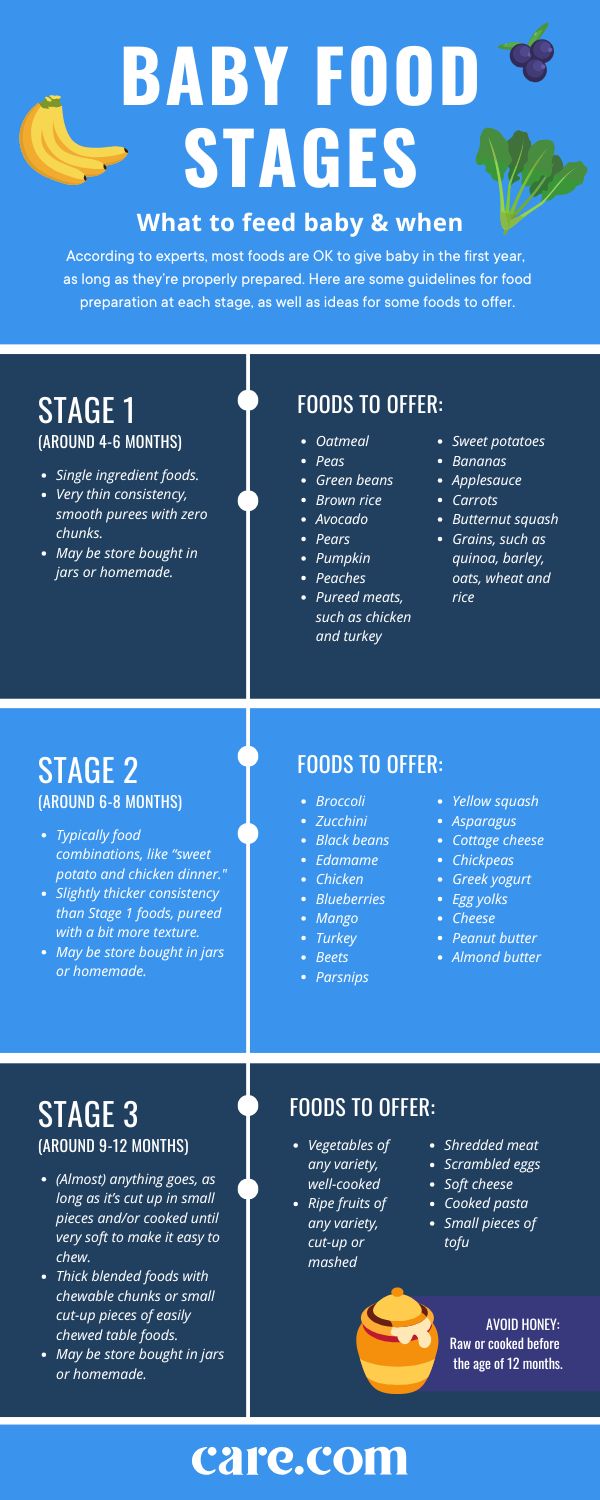Your baby’s made it through cereal mush, soupy carrots and ever-so-slightly texturized chicken and squash dinners. Now it’s time for the real culinary fun to start — welcome to Stage 3 baby food!
“Once your baby has successfully eaten Stage 2 foods, which have some texture to them, they can start Stage 3 foods,” says Dr. Melanie Custer, a pediatrician at West Bend Pediatrics, Children’s Wisconsin.
How do you know your baby is ready to make the leap from purees to slightly more sophisticated fare? Here, experts and parents weigh in on moving on to Stage 3 baby food. Time to dig in!
What is Stage 3 baby food?
Most jars of Stage 3 baby food are still pretty pureed (hence, the jars), but your little one needn’t be restricted solely to foods that are, for all intents and purposes, mush. Instead, you can steer your budding gourmand toward soft, small pieces of whatever you’re having. Think: cut-up pieces of turkey meatballs, banana chunks and small squares of tofu.
“Stage 3 foods are thick blended foods with chewable chunks, such as the kind you find at the grocery store, or small cut-up pieces of easily chewed table foods, which are usually referred to as ‘finger foods’,” says Dr. Kristen Treegoob, a pediatrician at Children’s Hospital of Philadelphia. (Avoid placing chunks of food in blends and purees, as it may cause a choking risk.)
“Stage 3 baby foods are thick blended foods with chewable chunks, such as the kind you find at the grocery store, or small cut-up pieces of easily chewed table foods, which are usually referred to as ‘finger foods.'”
— Dr. Kristen Treegoob, pediatrician
And be sure to bear in mind that every child is different and develops at their own individual pace. Check with your child’s doctor for baby food recommendations during the first year.
Stage 3 baby food age
“Typically, 9 months is the age babies start eating Stage 3 foods,” says Dr. Zulma Laracuente, a pediatrician in Alexandria, Louisiana. “But, generally-speaking, 9 to 12 months is considered a time of slowly transitioning your baby to table food.” (In other words, no more cooking and serving separate meals!)
Does that mean you baby is ready to tuck into a T-bone steak with a side of broccoli rabe? No. At least, not in the traditional form. But as long as food is small and very easy for baby to work through, it’s OK.
While the idea of having your 10-month-old feed themselves while you sit down to your own meal probably sounds heavenly, bear in mind, every child gets there in their own time.
“My first child couldn’t wait to eat mashed up meatballs and soft carrots on his own,” says mom of two Jennifer Reilly of New York City. “But my second? Not so much. Aside from puffs, I was still spoon-feeding him at nearly a year!”
Signs baby is ready to start Stage 3 or finger food
As your baby’s oral skills and hand-eye coordination develop, they’re moving closer to being able to feed themselves, either with their hands or a spoon. (Though, according to the Cleveland Clinic, babies usually don’t get the hang of utensils until at least 12 months.)
According to Jenifer Thompson, R.D., an advanced practice dietician at Johns Hopkins in Baltimore, babies can move past traditional baby foods and onto “pick-ups” (finger foods) as their pincer grasp skills are honed.
“By the time baby is between 8 to 12 months old, they should be able to pick up small, soft pieces of finger foods with their finger and thumb and bring them to their mouth,” she says.
Other signs your baby is ready to take meal time into their own hands? They tell you — as only a baby can.
“I knew my son was ready to try table foods when he started grabbing at the spoon every time I went to feed him,” says mom of two Darcy McConnell of Garwood, New Jersey. “Even though he didn’t actually use a fork or spoon for a few months, he loved holding on to them while he picked up his food. It was so cute!”
What Stage 3 foods to start with
Once you’ve hit the Stage 3 phase, (almost) anything goes, as long as it’s the right texture for baby. For instance, it’s OK to feed your child what the rest of the family is having for dinner, as long as you take proper precautions, such as making sure food is easy to chew and cut up into small pieces.
“Once babies are about 9 months old, they should safely be able to self-feed a variety of foods,” says Treegoob.
At this point in your baby’s life, solid food is starting to make up a significant part of their diet, so it’s important to offer foods that are nutritious. Also, exposing your child to different foods that are nourishing from an early age can help lay the groundwork for good, long-term habits.
“Parents should introduce a variety of healthy foods from different food groups with different textures by the end of the first year in order to help with healthy eating habits,” says Thompson.
“Parents should introduce a variety of healthy foods from different food groups with different textures by the end of the first year in order to help with healthy eating habits.”
— Jenifer Thompson, advanced practice dietician
Here are a few good choices for Stage 3 foods, according to Thompson and Treegoob:
- Well-cooked vegetables of any variety.
- Ripe fruits of any variety. (Mashed or cut-up bananas work very well at this stage.)
- Shredded meat.
- Scrambled eggs.
- Soft cheese.
- Cooked pasta.
- Small pieces of tofu.
Which foods to avoid during Stage 3
When your baby starts eating what the rest of the family is having, by all means, rejoice over having to prepare fewer dishes. However, if you’re hitting up the drive-thru after soccer practice with your older kid, skip the Happy Meal for your baby, regardless of how you serve it.
“When it comes to feeding babies, I recommend avoiding heavily salted or sweetened foods, as well as fast food,” says Treegoob.
The reason doctors advise being mindful of baby’s salt intake? In addition to it possibly contributing to bad eating habits overall, a 2011 study published in the European Journal of Clinical Nutrition found that infants who consumed over 400 milligrams of sodium per day (the maximum UK recommendation for children up to age 12 months) were potentially at risk of “harming developing kidneys” and causing “high blood pressure in later life.”
According to Treegoob, parents should also avoid any foods that may pose a choking risk to children, such as:
- Popcorn.
- Whole grapes.
- Whole peanuts.
- Raisins.
- Hot dogs.
- Hard candy.
- Seeds.
And finally, parents and caregivers should understand how long baby foods last and forgo giving a baby honey until after their 1st birthday, as it can cause a botulism infection.

How to start Stage 3 foods safely
As with Stage 1 and Stage 2 baby food, babies still should eat sitting upright with an adult nearby.
“Once an infant is ready for Stage 3 solids and is able to finger feed themselves, it’s still important to watch your baby eat, so you can help pace them and identify signs of choking early,” says Treegoob. “You can also offer them sips of formula, breast milk or a little water every few bites when they begin eating more than a few ounces at a time of Stage 3 foods to make sure they don’t eat too quickly.”
“Once an infant is ready for Stage 3 solids and is able to finger feed themselves, it’s still important to watch your baby eat, so you can help pace them and identify signs of choking early.”
— Dr. Kristen Treegoob
Also, be sure the food you’re giving your baby is prepared for their developmental stage. According to Kids Health, parents should slice food up into small pieces in addition to cooking it a little longer in order to make sure it’s very soft. (And, of course, check the temperature!)
Once your baby gets a taste of “real food,” don’t be surprised if their interest in formula or breast milk wanes.
“Between 7 to 9 months, parents may notice that their baby shows interest in smaller or less frequent bottles or breastfeeds,” says Treegoob. “As long as weight remains on track and the baby is staying hydrated, there’s no cause for concern.”
According to Treegoob, babies between 4 to 6 months old typically drink between 24 to 40 ounces of breast milk or formula per day; 24 to 32 ounces from 6 to 9 months; and by 9 to 12 months, when they’re eating more table foods, that volume can decrease to as low as 16 to 24 ounces.
The American Academy of Pediatrics recommends giving baby between 4 to 6 ounces of breast milk or formula four times a day, along with three meals a day and two small snacks. What you give your little one is up to you — just make sure it’s healthy and texturally appropriate for their age.


